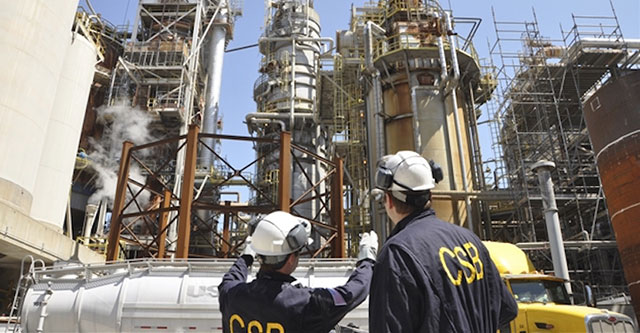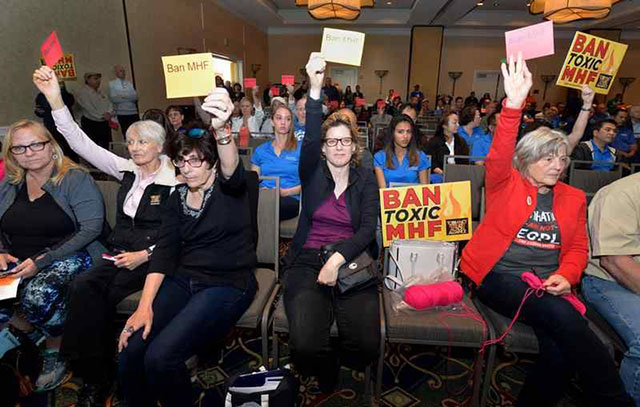
Outdated equipment, inadequate repair procedures, and a lack of safety standards led to a 2015 chemical explosion at the ExxonMobil refinery in Torrance, California, according to a report released this week by the U.S. Chemical Safety Board (CSB).
The explosion on the morning of February 18, 2015 released thousands of pounds of acid and caused chemical ash to rain on a heavily populated community for hours. Eight workers had to be decontaminated, and four were sent to hospitals with minor injuries.
The blast caused an 80,000 pound piece of debris to hit scaffolding in the refinery’s alkylation unit near a tank containing a form of hydrofluoric acid, which is used to increase the octane of gasoline and other products. A direct hit to the tank could have caused a catastrophic release of the chemical that could travel for miles, according to the CSB. In the wake of the blast, the California Division of Occupational Safety and Health (Cal/OSHA) ordered ExxonMobil to shut down the unit until it could demonstrate safe operations.
The idled refinery unit re-opened in May 2016, but local activists say it hasn’t gone far enough to avoid a future disaster.
Lack of “Robust” Safety Program
At a news conference in Torrance on Wednesday, Vanessa Allen Sutherland, chair of the Chemical Safety Board, detailed the multiple problems that led to the explosion, including the malfunction of a valve that should keep flammable hydrocarbons out of a unit that produced sparks. She added that the blast would have been prevented with the “implementation of a robust safety management program.”
Sutherland played an animated video produced by the CSB showing how a perfect storm of mechanical malfunctions and operating mistakes led to the explosion. She also shared several recommendations to prevent another disaster.
The CSB has the power to make recommendations but no authority to compel their adoption. Cal/OSHA, the state Environmental Protection Agency, and the South Coast Air Quality Management District (SCAQMD) oversee safety and environmental issues.
Since the February 2015 blast, the facility has been beset with other safety problems and small leaks. Before the 2015 explosion, state regulators had issued 19 health and safety citations against ExxonMobil.
ExxonMobil Responds
In an email, ExxonMobil spokesperson Todd Spitler said that the company “meets or exceeds accepted industry practices (API 751) and has stringent safety measures in place to mitigate risks associated with the modified hydrofluoric acid alkylation process.”
ExxonMobil sold the refinery to New Jersey-based PBF Energy in 2016. In an email PBF spokesperson Michael Karlovich said that the Torrance refinery has already implemented all but two of measures that address the CSB’s recommendations in the report.
“We plan to complete two studies later this year that will address the remaining recommendations. We have met with the CSB since acquiring the refinery and discussed with them the changes implemented here to further improve the safe, reliable, and environmentally responsible operations at the facility,” he wrote.
However, at the Wednesday news conference, CSB investigator Mark Wingard slammed ExxonMobil for not responding to many of its requests for information and said the company still had not given the board a number of required documents regarding safeguards to prevent hydrofluoric acid leaks.
Refinery Still Using Risky Chemical
On Wednesday, Sutherland said that the explosion could have had catastrophic impacts to the residential community surrounding the refinery. A fast-moving cloud of hydrofluoric acid could cause permanent lung damage or death. Even small amounts of hydrofluoric acid in aerosol form are dangerous.
However, ExxonMobil’s Spitler pushed back on the claim that the 2015 blast posed any risk to the community. “All safety systems and procedures operated as designed,” he wrote.
The CSB report stopped short of recommending that the refinery replace hydrofluoric acid — or even so-called modified hydrofluoric acid (MHF), which it uses now — with safer alternatives like sulfuric acid.
The refinery’s continued use of MHF worries both activists and residents of this densely populated region, approximately fifteen miles southwest of downtown Los Angeles.
“The refinery will not be fit until they get rid of hydrofluoric acid,” Jamie Court, president of Consumer Watchdog, told DeSmog.
“This is a Bhopal disaster waiting to happen in Torrance,” Court added, referring to the Union Carbide pesticide plant leak in India in 1984, which killed an estimated 15,000–20,000 people.
 Community activists at a Torrance City Council meeting in Torrance, California, south of downtown Los Angeles. (Credit: Torrance Refinery Action Alliance)
Community activists at a Torrance City Council meeting in Torrance, California, south of downtown Los Angeles. (Credit: Torrance Refinery Action Alliance)
Sally Hayati, leader of the Torrance Refinery Action Alliance (TRAA), one of the grassroots groups that formed after the 2015 explosion, told DeSmog that the claim made by the refinery’s owners — that the plant’s use of MHF has made operations safer — is “bogus.”
Hayati, a retired technical consultant with the Aerospace Corporation along with other members of TRAA’s science committee, determined that MHF is just as potentially dangerous as HF, despite chemical industry claims that a vapor suppressant additive reduces this risk.
“Even the industry’s own tests show that MHF wouldn’t be safe,” Hayati told DeSmog. “They’re putting out technobabble lies. No amount of HF is safe.”
Hayati told DeSmog that the chemical industry doesn’t want a precedent set by any regulatory agencies banning MHF. At the Torrance plant, the issue is money, she says. Switching to a safer alternative likely would require the owner to build a new unit that would cost at least $100 million.
“The owners of the Torrance refinery won’t change over to a safer system,” Court told DeSmog. “It will take legislation.”
An Opaque Industry’s “Trade Secrets”
Hayati told DeSmog that research done by fellow scientists and other members of the TRAA was behind much of the information that’s been revealed about the Torrance refinery blast, both in the CSB report and in the media.
“The industry has been getting away with secrecy,” she told DeSmog. “In 2015 a CSB member came to one of our community meetings where I was giving a presentation on HF. I thought, great, I have questions for him, but he said, ‘we have a lot of questions for you.'”
The opacity stems from agreements by government agencies and municipalities to not release information or “trade secrets” that could put a company or manufacturer at a competitive disadvantage.
“But a lot of this information is in the public domain already,” Hayati said.
She added that such trade secret laws were written to shield dangerous processes from the public right to know, but they don’t prevent the public from digging them up.
Though the Torrance refinery is located in an industrial corridor, about 100,000 people live within five miles of the plant. Last month approximately 500 community residents marched in an unusual southern California rain storm to protest the use of hydrofluoric acid at the refinery.
Join us in defending the truth before it’s too late
The future of independent journalism is uncertain, and the consequences of losing it are too grave to ignore. To ensure Truthout remains safe, strong, and free, we need to raise $43,000 in the next 6 days. Every dollar raised goes directly toward the costs of producing news you can trust.
Please give what you can — because by supporting us with a tax-deductible donation, you’re not just preserving a source of news, you’re helping to safeguard what’s left of our democracy.